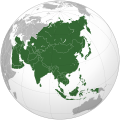| Part of the Politics series |
| Party politics |
|---|
| |
This page serves as a directory to lists of political parties worldwide, organized by their respective regions. Each linked page contains a table listing sub-pages for countries or jurisdictions within the specified region. The tables provide information on the dominant party system in each country.
Contents
A political party is an organized group that adheres to a specific ideology or revolves around particular issues, aiming to participate in political power, often through elections involvement. Individual parties are appropriately detailed in separate articles dedicated to each nation.










